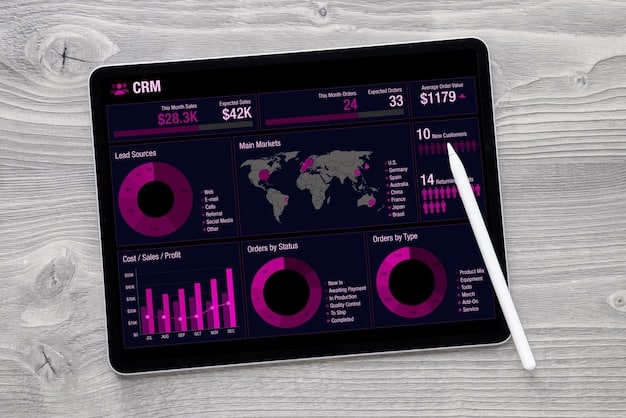Earn Extra Income: 3 Personal Finance Tips for Side Hustles in 2025

Considering a side hustle to boost your income in 2025? This article explores three crucial personal finance tips: budgeting for success, strategic investing in your side hustle, and mastering tax planning to maximize your earnings and minimize financial stress.
Want to earn extra income in 2025? Launching a side hustle can be an excellent way to supplement your income, but financial discipline is key to ensuring its success and your overall financial well-being.
Budgeting for Side Hustle Success
Creating a budget is the cornerstone of any successful financial endeavor. When it comes to side hustles, a well-defined budget helps you track income and expenses, allocate resources effectively, and ensure your hustle remains profitable.
Let’s explore the steps to create a budget: defining financial goals, tracking income and expenses, allocating funds, and monitoring your progress.
Define Your Financial Goals
Before diving into the numbers, clarify your financial goals for the side hustle. Are you looking to pay off debt, save for a down payment on a house, or simply increase your disposable income? Clearly defined goals will drive your budgeting decisions.
Track Income and Expenses
Keep a detailed record of all income generated by your side hustle and all associated expenses. Use budgeting software, spreadsheets, or mobile apps to track every transaction. Accurate tracking provides a clear picture of your financial performance.

Allocate Funds Strategically
Allocate funds based on your financial goals and priorities. Determine how much of your side hustle income should be allocated towards business expenses, taxes, personal savings, and debt repayment. A well-thought-out allocation plan ensures you’re using your income effectively.
- Separate business and personal accounts to simplify tracking.
- Allocate a percentage of each payment towards taxes to avoid surprises.
- Build an emergency fund to cover unexpected business or personal expenses.
Regularly review your budget and make adjustments as needed based on your side hustle’s performance and changing financial circumstances. Flexibility is crucial for long-term success.
Investing in Your Side Hustle for Growth
Strategic investments are crucial for scaling your side hustle and increasing its profitability. By identifying key areas for investment and allocating resources effectively, you can fuel growth and maximize your return.
There are several investment opportunities: education and skill enhancement, marketing and advertising, and technology and equipment upgrades.
Education and Skill Enhancement
Investing in your knowledge and skills is one of the most effective ways to grow your side hustle. Take courses, attend workshops, or hire a mentor to enhance your expertise in your field. Continuous learning keeps you competitive and improves your service offerings.
Marketing and Advertising
Effective marketing and advertising are essential for attracting new customers and growing your side hustle. Invest in online advertising, social media marketing, content creation, or public relations to increase your brand visibility and reach your target audience.
Technology and Equipment Upgrades
Upgrading your technology and equipment can improve efficiency, productivity, and the quality of your services. Invest in new software, hardware, or tools that streamline your operations and allow you to deliver better results for your clients or customers.

Consistent investment in education, marketing, and technology can compound over time, leading to significant growth and increased profitability for your side hustle.
Mastering Tax Planning for Side Hustlers
Tax planning is an essential aspect of managing your side hustle finances. By understanding your tax obligations and implementing effective strategies, you can minimize your tax liability and maximize your net income.
Let’s explore a few tax tips: tracking deductible expenses, utilizing tax-advantaged accounts, and consulting with a tax professional.
Track Deductible Expenses Meticulously
As a side hustler, you’re entitled to deduct certain business expenses to reduce your taxable income. Keep detailed records of all eligible expenses, such as office supplies, travel costs, marketing expenses, and home office deductions. Accurate expense tracking can significantly lower your tax bill.
Utilize Tax-Advantaged Accounts
Take advantage of tax-advantaged retirement accounts, such as SEP IRAs or solo 401(k)s, to save for retirement while reducing your current tax liability. Contributions to these accounts are often tax-deductible, offering immediate tax benefits and long-term savings potential.
- Open a SEP IRA to contribute up to 20% of your net self-employment income.
- Consider a solo 401(k) for higher contribution limits and additional tax benefits.
- Consult with a financial advisor to determine the best retirement savings strategy for your needs.
Consult with a Tax Professional
Navigating the complexities of self-employment taxes can be challenging. Consider consulting with a qualified tax professional who can provide personalized guidance, ensure compliance with tax laws, and help you identify additional tax-saving opportunities. A tax professional’s expertise can save you time, money, and potential headaches.
Proactive tax planning is a critical component of financial management for side hustlers. By staying informed and seeking professional advice, you can optimize your tax strategy and keep more of your hard-earned income.
| Key Point | Brief Description |
|---|---|
| 📊 Budgeting | Track income/expenses, allocate funds wisely, and regularly review for profitability. |
| 🚀 Investing | Invest in education, marketing, and tech upgrades to scale your side hustle. |
| 💰 Tax Planning | Track deductible expenses, use tax-advantaged accounts, and consult a tax pro. |
| 🎯 Financial Goals | Define clear financial goals to guide your side hustle’s budgeting and investment strategies. |
Frequently Asked Questions
▼
Start by listing all potential income streams and anticipated expenses. Prioritize essential expenses and allocate funds for savings and taxes. Regularly review and adjust based on actual performance.
▼
Leverage social media, create valuable content, network within your industry, and utilize free online directories. Focus on targeted marketing to reach your ideal customer base.
▼
SEP IRAs and solo 401(k)s are popular choices. Consult with a financial advisor to determine the best option based on your income, savings goals, and tax situation.
▼
Review your financials monthly to identify trends, make necessary adjustments, and ensure you’re on track to meet your financial goals. Quarterly reviews can provide broader insights.
▼
Assess the situation, adjust your budget, explore new income streams, and consider seeking advice from a financial mentor. Staying proactive and adaptable is crucial during challenging times.
Conclusion
By implementing these personal finance tips, you can set your side hustle up for success in 2025. Budgeting, strategic investing, and smart tax planning empowers you to maximize your earnings, minimize financial stress, and achieve your entrepreneurial goals.





